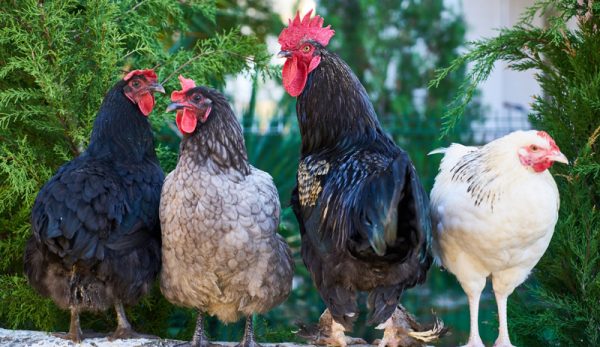
There are hundreds of chicken breeds in the world—a staggering number when you think of their humble beginnings as the Red Junglefowl. Around 90 breeds are accessible to the backyard owner, but if you throw in other types of poultry such as geese, ducks and turkeys, the choice is almost endless.
The common first reaction is to pick the breed that catches your eye. And who can blame you? A coop full of Seabrights or Polish would make a pretty picture, as would a pond full of ducks.
But beauty aside, are those birds really the right choices for your farm? The best way to find out is to break them down by use and choose poultry based on your needs.
Dual-Purpose Group
The dual-purpose chicken is an egg and meat bird. They are attractive birds and tend to be friendly and easy to keep. They lay a good amount, and some of the eggs are interesting, such as the multi-colored eggs of the Ameraucana.
But dual-purpose breeds lay fewer eggs than the egg-laying breeds.
Dual-purpose breeds make nice tasting broilers but they develop slowly and have less breast meat. Also, since you’ll have the bird longer than a meat bird, you or your family might bond with the animal and have a hard time letting it go or even eating it.
Dual-purpose breeds include the Jersey Giant, Brahma, Buckeye and Orpington.
Read more: Thinking about raising chickens? These tips will give you a great start.
Ornamental Group
The ornamental breeds are the beauty queens of the poultry world, so choose them if you’re looking for fancy. They are specifically bred for their fancy features, such as elaborate combs (like the Redcap), unusual looks (like the Seabright bantam) or unique plumage (like the Silkie).
If you want them to keep their looks, ornamental breeds will require pampering, special housing that’s impeccably clean and fully out of the weather.
Eggs are usually smaller and less plentiful than those of other breeds. Some of the ornamental breeds (such as the Silkie and Showgirl bantams), with their fluffy plumage and agreeable natures, make wonderful pets, especially for children.
Meat
Generally speaking, meat chickens (usually called broilers) are hybrids bred for large breast-meat yields and their astounding conversion of feed to meat. The Cornish hen is the foundation for meat breeds.
Meat birds come to market at 6 to 8 weeks old, and you aren’t doing them a favor by letting them continue any longer than that. Their ability to grow quickly comes with problems such as leg disorders, breast blisters and a fatal heart-attack condition called flip-over.
Meat birds do not perch and so they need special bedding, such as sawdust, to keep their skin healthy. Because they don’t move around easily, meat birds need feeders and water founts within easy reach.
Despite all of this, you want to choose broilers for meat poultry. Because they come to market quickly, there’s less chance to become emotionally attached.
Hybrid meat “breeds” include the Freedom Ranger and Cornish Cross.
Read more: Can you raise meat chickens off the grid? Yes, with a few extra considerations.
Egg-laying Group
If you want lots of chicken eggs, look no further than the egg-laying group. Their origins come from the Mediterranean class, and they usually have smaller bodies with little meat because they use nutrients to make eggs.
Egg laying breeds tend to be flighty and aloof. They also tend to be more aggressive towards breeds in the other categories. They are very difficult to catch and aren’t easily tamed.
Egg-layers include the industrial Leghorn, White Leghorn, Welsummer and Production Red.
Game Birds
Game birds are traditionally used for hunting purposes, but nowadays they have extra purposes. These birds include Guinea fowl, turkey, quail and waterfowl, such as geese and ducks.
There are also ornamental game birds such as the Ornamental Pheasant.
Game birds can be used for tick control (guinea fowl), weeding (geese and ducks), mosquito control (Muscovy duck), guarding/alarm (geese), gundog training, shooting and, of course, for meat and/or eggs (geese, ducks, turkeys, quail, pheasant).
Game birds can be touchy and difficult to handle. Geese, for instance, can be downright fierce during breeding season. They make good guard animals but aren’t fun to be around.
Guinea fowl are difficult to house. They are known for leaving the farm altogether for greener pastures.
Each game bird type will need specific housing and care, so make sure to carefully research the one you’re considering before purchase.
Sidebar: All Together?
Keeping all your birds together under one roof might seem convenient, but it can set you up for headaches.
Birds of a feather do tend to flock together. If you have one red chicken and several white chickens, the red chicken will be the odd bird out, left to fend for itself.
Less ornamental breeds might curiously peck at the feathery hat of the Polish or the decorative comb of the Redcap. And slow meat birds will be pushed away from food and water.
Some birds cannot be kept together for health reasons, such as chickens and turkeys. Others have different needs, such as turkeys that don’t roost, and geese that need buckets of water for bathing and straw beds for sleeping.
Therefore, all types should have their own housing. If your farm doesn’t have the room, choose one type of poultry and stick to it.




